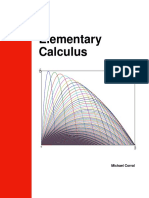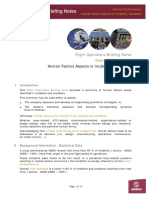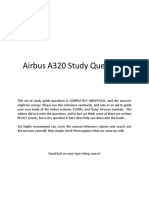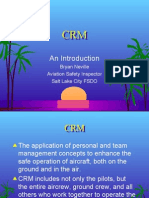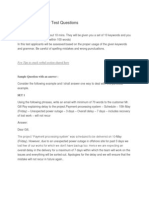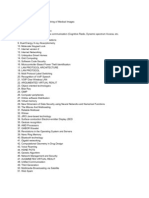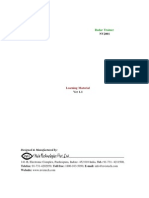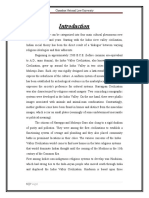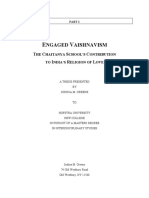Professional Documents
Culture Documents
A Hidden Renaissance in Bengal: The Rebirth' of Subaltern Matua' Namasudras
Uploaded by
IJELS Research JournalOriginal Title
Copyright
Available Formats
Share this document
Did you find this document useful?
Is this content inappropriate?
Report this DocumentCopyright:
Available Formats
A Hidden Renaissance in Bengal: The Rebirth' of Subaltern Matua' Namasudras
Uploaded by
IJELS Research JournalCopyright:
Available Formats
International Journal of English Literature and Social Sciences
Vol-6, Issue-4; Jul-Aug, 2021
Journal Home Page Available: https://ijels.com/
Journal DOI: 10.22161/ijels
Peer-Reviewed Journal
A Hidden Renaissance in Bengal: The ‘Rebirth’ of
Subaltern ‘Matua’ Namasudras
Dr. Milan Mandal
Ex-PhD Research Scholar, Department of English, Seacom Skills University, Bolpur, Pin Code- 731204, W.B. India.
Received: 17 Jul 2021; Received in revised form: 10 Aug 2021; Accepted: 22 Aug 2021; Available online: 27 Aug 2021
©2021 The Author(s). Published by Infogain Publication. This is an open access article under the CC BY license
(https://creativecommons.org/licenses/by/4.0/).
Abstract— The caste system in Hindu religion operates stratification which constitutes social hierarchy.
The Brahman is at the apex of this hierarchy, with the Kshatriya second; Vaisya third in rank. The fourth is
the Sudra, the ‘footman’, the servant of former three varnas. This sect is alienated as untouchable in this
hierarchical order since the Rig Vedic era. The ‘Chandal’ (later allowed as Namasudra) of Bengal is a
severely unprivileged segment of Sudra. In the late nineteenth and early twentieth century, this sector
rebelled against the oppression, exploitation and persistent humiliation of the ‘upper’ Varnas under the
leadership of Sri Sri Harichand Thakur and later by his son Sri Sri Guruchand Thakur. They promoted an
alternative socio-religious Matua movement to awake the marginal Namasudras to make their distinct
identity. They took extensive education as means of their intellectual and social upliftment. The influence of
the education movement continues its widespread influence till today. Agonisingly, the history of this
renaissance movement is kept almost silenced in the caste dominated testimonials and elite history. The
paper, therefore, attempts to unearth this glorious history of academic and social elevation of the
unacknowledged Bengali Namasudras.
Keywords— Education, Hide, Matua, Movement, Namasudra, Renaissance.
I. HISTORY OF NAMASUDRAS Mahananda Halder in his Sri Sri Guruchand Charit states
Namasudra as a distinct sect has its own historical that after Pala Empire Bengal was under the reign of Sena
root. It has been a subject of debate regarding the origin of kings who were the patrons of Brahmanism. Hence, they
Namasudras. Namasudra as a sub-caste originated from the unleashed their severe atrocities on the Buddhists and
Aryanisation processes which led to gradual absorption of deprived of their social and religious rights. Those
non-Aryans into the four-fold Varna system. Later on, the alienated Buddhists were identified as Namasudras and
Varna system turned into jati system based on they were made the objects of social oppression and
occupational distinctions among various varnas. In Bengal, discrimination for generations. Snigdhendu Bhattacharya
the continual spread of Aryanisation led to the has put almost the same view:
classification of different sects with typical occupations as Some early Bengali historians refer to them as
distinct jatis. The people, who were mostly engaged with ‘Brahmin-Buddhists’ who refused to accept Hinduism
diverse occupations like fishing, cultivation, carpenting, after the decline of the Pal dynasty and the rise of the
boating, roof thatchering, weaving, and egg and vegetable Hindu revivalist Sen dynasty, which ruled in the 11th and
selling, came to be recognized as Sudra (Namasudra) in 12th centuries CE.
terms of Varna. According to Sekhar Bandyopadhyay, Whatever the origin of Namasudras - through the
Namasudra is a settled ‘peasant community’ (Caste, Aryanisation process, conversion from Buddhists or from
Culture and Hegemony 154). The Namasudras inhabited in Brahmanism- is, it is the very fact that they have been
marshy Eastern Bengal districts of Faridpur, Khulna, made objects of oppression in social organization and
Dhaka Bakerganj, Jessore and Mymensingh. Acharya
IJELS-2021, 6(4), (ISSN: 2456-7620)
https://dx.doi.org/10.22161/ijels.64.41 266
Milan Mandal A Hidden Renaissance in Bengal: The ‘Rebirth’ of Subaltern ‘Matua’ Namasudras
institution. The author Dr. Pandharinath H. Prabhu has inter-caste marriage etc and that way they tried to build an
represented the essentials of Hindu social thought and alternative, non-hierarchical society (368).
organization in his book Hindu Social Organization and The great essence of the Matua religion is the unification
interpreted that “The creation of the Sudra from the foot of Karma (work) and Dharma (religion): “Haate kaam aar
symbolizes the fact that the Sudra is to be the ‘footman’, mukhe nam” (“work with your hands and chanting [of
the servant of other varnas (286). The French Haribol] with your mouth” is the core message of the
anthropologist Louis Dumonto views in his Homo Matuadharma. The professor Sipra Mukherjee has rightly
Hierarchichus that the “Caste system as an extreme form stated in her article “In Opposition and Allegiance to
of ‘social stratification’ (3) in Hindu society in which Hinduism: Exploring the Bengali Matua Hagiography
people of hierarchical strata denies the ‘rights’ of dalits: Harichand Thakur” that:
“Our two cardinal ideals are called equality and liberty”
The Matua dharma, a dissenting faith against the
(4). The Namasudras are alienated as untouchables in the
established Brahmanical faith, nurtured the
hierarchical order of ‘Hindu’ society.
community’s spirit of independence and dignity, enabling
it to move up the economic ladder through its secular ethic
II. HARI CHAND THAKUR’S MATUA of work (16).
RELIGION: A MOVEMENT OF SOCIAL Manoranjan Byapari, one of the most renowned authors of
AWAKENING the Namasudra community, has represented the secular
Sri Sri Harichand Thakur (1812-1877), a dalit, ethic of the Matuas religion in his book Matua Ek Mukti
who was born at Safladanga in the district Faridpur (now Sena (Matua, the Freedom Fighters, 2013).
in Bangladesh), rebelled against the social injustice of Harichand Thakur perceived that education is the
caste Hindus. He introduced an alternative ‘Matua utmost means which can bring the financial independence
religion’ to revive own rights and distinct socio-political and social rights of subaltern people. Hence, he assigned
entity during the end of the nineteenth century. He aimed his son Sri Sri Guruchand Thakur to spread education
“to achieve social freedom for the untouchables.” among Namasudras: “My father Harichand advised me, /
According to the historian Sekhar Bandyopadhyay, To provide education to the doors of my own clan.”
Harichand Thakur “was born in this world to bring (Mahananda Halder 108, translation mine).
salvation to the downtrodden" (The Matua Sect and the
Namasudras" 163). He also states that the Matua
community was formed as ‘a protestant Vaishnava III. GURUCHAND THAKUR’S EDUCATION
religious sect’ that rejected the humiliating hegemony of MOVEMENT
the Brahmanical Varna in order to create an independent Guruchand Thakur (1846-1937) took up the
identity rejecting the Vedas, and their rituals. The president leadership of the Matua religion and brought about a
of the Bangla Dalit Sahitya Sangstha, Manohar Mouli renaissance, the ‘rebirth’ (transformation which is
Biswas also opines the same view of “Matua faith as being culminated through ‘a series of social, political, and
in opposition to Brahmanism, the Vedas and their rituals” intellectual transformations.’) among the illiterate and ever
(Sipra Mukherjee, 3). oppressed marginal. He renewed the religion through the
The Matua dharma begins “with a defiant unification of Shakti (potentiality) and Bhakti (devotion);
opposition to Brahmanical Hinduism.” It is a separate Dharma (religion) and Karma (work). He renamed the
religion outside of Hinduism, which denies the Matua Sangha as Matua Maha Sangha.
Brahmanical Varna system and against the rules of Veda, Guruchand Thakur prioritised the work of
priestly hedonism and rituals. Instead, Harichand’s Matua spreading education in underdeveloped societies as
religion was based on secularism, love, gender equality directed by his father Harichand Thakur: “Get educated
and unification of untouchables and the oppressed people. first, and then make family”. According to Sekhar
Manosanta Biswas in his article “De-Sanskritization and Bandyopadhyay, he was the true pioneer of Namasudra
Social Mobilization”: has also unfolded the fundamental renaissance under whom “the sect achieved its doctrinal
principles of Matua movement: cohesion and organizational push” (Caste, Culture and
Alternative reform movements had the courage to Hegemony 96). He comprehended that it was not possible
build separate caste identities by defying the caste to have social rights through religion. Hence, he
distinction and rejecting the Brahministic customs and introduced extensive education movement and messaged
rituals. They gathered liberty to their women, allowed his community stating that: “Uneducated man is like a
IJELS-2021, 6(4), (ISSN: 2456-7620)
https://dx.doi.org/10.22161/ijels.64.41 267
Milan Mandal A Hidden Renaissance in Bengal: The ‘Rebirth’ of Subaltern ‘Matua’ Namasudras
beast, / With lights of education take fire religious He urged to increase the sense of rights and self-awareness
knowledge to the life.” (Quoted from Sipra Mukherjee 16) among the alienated and deprived people of Bengal. He
The historical symposium, the Nikhilbanga messaged to them that illiteracy is the root of their
Namashudra Mahasammelan (All Bengal Namasudra deprivation and pledged them to be educated to have their
Conference) endeavored by Guruchand Thakur in 1907 in own rights:
Khulna (now in Bangladesh), was organised to determine Due to our illiteracy, we are deceived.
the future outlines of his movement. The movement was So, I say, if you wish to be free, you must be
aimed at the embracement of education to have social and educated yourselves.
political right. His educational vibrance unlocked new
If you have education, grief will go away,
doors for dalits and backward classes all over Bengal. It
also brought about immediate and continuing effects. The And be happy forever on the earth. (Mahananda
American historian Katherine Mayo in her book Mother Halder 130, translation mine).
India (1927) has statistically shown the educational He began to establish schools with his tired-less efforts for
elevation of this dalit community: the elevation of the unlettered oppressed people of Bengal.
By the last report they had in Bengal over 49,000 It was very difficult enterprise for him to set up academic
children under tuition, of whom 1,025 had reached institutions. There were financial crisis to institute school
the High School and 144 the Arts Colleges, where, buildings, denial of the educated caste Hindus to teach in
because of caste feeling, Government has been obliged those schools as well as the reluctance of the poor to read.
to set aside special hostels for their lodging. This Under those critical conditions, Guruchand Thakur set up
community is rapidly raising its status (160). his first school in his own house in 1880 and it was
upgraded to a high school in 1908. In the same year, the
Although able to pass, educated Namasudras were not
first English-medium high academy was set up in his
entitled to jobs, as they belonged to untouchable society.
village. It was an unprecedented initiative for the
Guru Chand Thakur gave a deputation against that
unprivileged illiterate people of Dalit society.
discrimination to the British government on 14 August
1907 and it resulted that the learned youth of the A Namashudra Mahasammelan chaired by
untouchable society of Bengal got the right to participate Guruchand Thakur was held in 1881 to convey the essence
in the first government service in 1908. of inevitability of education in dalit Namasudras and the
way of its spreading among them. In his speech at the
Guruchand Thakur was also an uncompromising
convention, he proclaimed to accept education as the only
fighter on the question of self-esteem. In 1871, in the
way to uplift illiterate dalit people: “There is no regret in
'census' of the British government led by the caste Hindus,
living or dying, /I prefer to build schools from village to
the Namasudras were registered as 'Chandals'. The
villages (Halder 145, translation mine). By 1931, he
agitation stirred by Guruchand Thakur and Dr. C.S. Mead
established a total of 1820 schools in undivided Bengal. Dr
forced the English government to use the word
C. S. Mead, an Australian Baptist missionary, was of
'Namasudra' instead of 'Chandal' in the 1911 Census
immense help to him in the education and social justice
Report.
movements.
He unrolled the message among the unlettered
Guruchad Thakur was truly the pioneer of dalit
Namasudras that religion can satisfy the hunger of the
renaissance in Bengal. He apprehended the necessity of
human mind, but it can never satisfy the hunger of the
women education. He built numerous schools for girls. He
human stomach. He perceived that only knowledge can
also set up a training academy for women. He donated a
liberate the marginal and oppressed people from the
boat for the girls to go to school. He also began a new era
oppression of caste Hindu and hunger and only knowledge
by initiating the widow-marriage and an ‘Ashram’ for
can make them happy forever. Hence, he instructed his
them with assistance of Dr. C.S. Mead’s wife.
disciples to educate their children:
The caste Hindu attempts to lower the
I tell you all if you obey me,
significance of the Matua movement and has kept almost
Never make your sons unlettered. hidden in the history. The faith of this religion is love and
There is no sorrow in eating or fasting, love to all, irrespective of caste, creed and religion. Sri
What I want is to teach children. (Mahananda Thakur did not confine his movement of education only to
Halder 144, translation mine) Matua sector. Indeed, it was spread among other depressed
castes like Teli, Mali, Kumbhakar, Kapali, Mahishya,
Yadav, Das, Chamar, Kamar, Tanti and even Muslim.
IJELS-2021, 6(4), (ISSN: 2456-7620)
https://dx.doi.org/10.22161/ijels.64.41 268
Milan Mandal A Hidden Renaissance in Bengal: The ‘Rebirth’ of Subaltern ‘Matua’ Namasudras
Shri ‘Rajarshi’ Guruchand Thakur induced the to focus on the history of education and social movements.
“intense interest in education” among the subaltern class Very recently, Prof. (Dr.) Tapan Kumar Biswas, the
and he was also able to convey the value of their Hon’ble Vice-Chancellor of the University Harichand
schooling. This consciousness of education resulted to set Guruchand University (HGU) and his eminent associates
up lots of colleges and universities by his followers in have established the Centre for Matua Studies (CMS) to
India and Bangladesh, as after the partition of India extend Guruchand’s education movement and ‘the culture,
in1947, a major number of Matuas migrated to India and heritage, and prospect of Matua Community’ in modern
formed their second organisation in Thakurnagar, West age.
Bengal, India. The elite chroniclers never perceive to focus on
this repressed history. Rather, the history of Namasudra
IV. CONCLUSION renaissance movement has been almost inaudible in their
conventional history, except in the testimonials of dalit
Hari Chand Thakur and more particularly
intellectuals. It is, thus, undeniable that the history of the
Guruchand Thakur initiated renaissance, a ‘revival of
sublime renaissance of subaltern Namasudras of Bengal is
interest’ in education and social awakening, which
marginalised in elite history.
enlightened the dalit Namasudras. Sadly, the history of this
Bengal renaissance is kept almost hidden in the elite
history. In his letter (1921), the Australian Baptist REFERENCES
missionary Dr C. S. Mead unrolled his delation for the [1] Bandyopadhyay, Sekhar (2004). Caste, Culture and
negligence by the caste Hindus to Guruchand Thakur and Hegemony: Social Dominance in Colonial Bengal. London:
his regard to Guruchand for his ‘ability and wide-spread Sage.
influence’ on Namasudras, stating that “foreigner [Mead] [2] Bandyopadhyay, Sekhar (2009). “Partition and the
is able to realize him [Guruchand] and so obeys him” Ruptures in Dalit Identity Politics in Bengal”. Asian Studies
(https://sites.google.com/view/srisriguruchand-charit/417, Review, Vol. 33, Issue 4, pp 455-467.
[3] Bandyopadhyay, Sekhar (1995). “The Matua Sect and the
translation mine).
Namasudras”. Mind Body and Society: Life and Mentality
The history of this dalit renaissance reiterated by in Colonial Bengal (edited by Rajat Kanta Ray). Oxford:
the two humanists was first truly unveiled in Sri Sri Oxford University Press.
Harililamrita (1917) by the dalit poet Tarak Chandra [4] Bhattacharya, Snigdhendu (March 26th 2021). “Bengal’s
Sarkar and in Sri Sri Guruchand Charit (1943) authored Namasudras: from socially unprivileged Namasudra
by Mahananda Halder. These two texts mirror the history Dismissed to Decisive”. Live History India.
https://www.livehistoryindia.com/story/mmi-cover-
of ‘Chandal’ community, the ethics of the Matua religion
story/bengals-namasudras/).
and the social awakening movement. Sipra Mukherjee in
[5] Biswas, Manohar Mouli (2015). Surviving in My World:
her article has also stated the fact Guruchand Charit is the Growing up Dalit (Trs. & Eds. Angana Dutta and Jaydeep
first book which unfolds the movements of Namasudra Sarangi, Bengali Amar Bhubane Ami Benchi Thaki).
community: Kolkata: Samya Publishers.
Guruchand Charit, authored by Mahananda [6] Biswas, Manosanta (2015). “De-Sanskritization and Social
Mobilization: An Alternative Socio-religious Movement of
Halder is a valuable text and the Life-Veda (‘Jeevan-
'Matua'-Namasudras of Bengal.” JSTOR, Indian History
Veda’) of the Matua sect. It is a grand narrative of the
Congress, Vol. 76, pp. 368-375. Retrieved from
struggle for freedom of Bengal’s underprivileged and https://www.jstor.org/stable/44156603).
disadvantaged classes No history of these people has been [7] Byapari, Manoranjan (2012). Itibritte Chandal Jibon
written before this. ((Mahananda Halder, Guruchand (Vol.1). Kolkata: Kolkata Prakashan.
Charit, p. v; quoted from Sipra Mukherjee 10). [8] Dumonto, Louis (1980). Homo Hierarchichus: The Caste
System and Its Implications (translated by Mark Sainsbury).
Tarak Chandra Sarkar, the pioneer of Kavigaan (a kind of
Chicago: University of Chicago Press.
song tournament) and his successors such as poet Haribar,
[9] Haldar, Mahananda (2009). Sri Sri Guruchand Charit. 5th
Manohar, Rajendranath Sarkar, Vijay Sarkar, Nishikanta Reprinted Resolution, Thakurnagar: Modern Press.
Sarkar” and the recent dalit folk-poets Surendra Nath [10] Mayo, Katherine (1931). Mother India. New York: Blue
Sarkar, Amulya Ratan Sarkar, Srinibas Sarkar, Asim Ribbon Books.
Sarkar, Mano Ranjan Sarkar and Uttam Sarkar take the [11] Mukherjee, Sipra (2018). “In Opposition and Allegiance to
promising role to “promote the idea of social reformation Hinduism: Exploring the Bengali Matua Hagiography
through the lyricism of rhymed verse” (Jaydeep Sarangi Harichand Thakur”. South Asia: Journal of South Asian
12). A number of dalit writers like Manohar Mouli Studies, DOI:10.1080/00856401.2018.144540.
https://doi.org/10.1080/00856401.2018.1445400.
Biswas, Manoranjan Byapari, and Nakul Mallik are trying
IJELS-2021, 6(4), (ISSN: 2456-7620)
https://dx.doi.org/10.22161/ijels.64.41 269
Milan Mandal A Hidden Renaissance in Bengal: The ‘Rebirth’ of Subaltern ‘Matua’ Namasudras
[12] Prabhu, Pandharinath H. (1963). Hindu Social
Organization: A Study of Socio-Psychological and
Ideological Foundations (4th Ed.). Bombay: Popular
Prakashan.
[13] Sarangi, Jaydeep (2, August 2018). “Towards the Cultural
Banner of Bangla Dalit Literary Movement: An Interview
with Nakul Mallik. Writers in Conversation. Vol. 5, Issue.
2. Retrieved from journals.flinders.edu.au
[14] Sarkar, Tarak (2007). Sri Sri Harileelamrita (8th Ed.)
Thakurnagar: Modern Press.
IJELS-2021, 6(4), (ISSN: 2456-7620)
https://dx.doi.org/10.22161/ijels.64.41 270
You might also like
- PQM Quiz FinalDocument11 pagesPQM Quiz FinalSyeda Sadaf ZahraNo ratings yet
- Elementary CalculusDocument348 pagesElementary CalculusSixth InkerNo ratings yet
- Civil Aviation English For Pilots - An English Air-Ground CommunicDocument105 pagesCivil Aviation English For Pilots - An English Air-Ground CommunicErmiyas AlemayehuNo ratings yet
- Atpl Radio & InstrumentsDocument76 pagesAtpl Radio & Instrumentsdahiya1988No ratings yet
- Spatial DisorientationDocument30 pagesSpatial Disorientationyan2901No ratings yet
- Phraseology Study PDFDocument89 pagesPhraseology Study PDFMarcelo NobregaNo ratings yet
- Required Obstacle ClearanceDocument14 pagesRequired Obstacle ClearancePero PericNo ratings yet
- Post Market Surveillance SOPDocument8 pagesPost Market Surveillance SOPgopinathNo ratings yet
- PilotDocument25 pagesPilotDENISSE MACIASNo ratings yet
- 4) Handbook of Aeronautical KnowledgeDocument356 pages4) Handbook of Aeronautical Knowledgeleather_nun100% (1)
- Spatial Disorientation in AviationDocument12 pagesSpatial Disorientation in AviationT-CAS0% (1)
- SimpleInterest Compound InterestDocument44 pagesSimpleInterest Compound InterestAnk KoliNo ratings yet
- Lesson AerodynamicsDocument113 pagesLesson AerodynamicsShermeen Khan100% (1)
- All Weather Operations GuideDocument254 pagesAll Weather Operations GuideSkoltzAllaniNo ratings yet
- Human Factors Aspects in Incidents and Accidents PDFDocument10 pagesHuman Factors Aspects in Incidents and Accidents PDFLuis Eduardo Dos SantosNo ratings yet
- Command&Sa&Comm&Crm 1Document20 pagesCommand&Sa&Comm&Crm 1saban2139No ratings yet
- 3 Maintaining Manual Flying Skills - Jacques DrappierDocument6 pages3 Maintaining Manual Flying Skills - Jacques DrappierEduardo Dantas LobãoNo ratings yet
- Archaeology - October 2016 PDFDocument72 pagesArchaeology - October 2016 PDFOmer CetinkayaNo ratings yet
- MECN 3350 - Aircraft Design and Performance - Module 5 - Unit 5.1 - Lesson 5.1.2Document64 pagesMECN 3350 - Aircraft Design and Performance - Module 5 - Unit 5.1 - Lesson 5.1.2Jose A Rosado LopezNo ratings yet
- Falcon Aero Club (Salem) : Session 1Document2 pagesFalcon Aero Club (Salem) : Session 1karthipriyaNo ratings yet
- Phraseology From AIP v2 PDFDocument38 pagesPhraseology From AIP v2 PDFRobbie van LeeuwenNo ratings yet
- Smart Cockpit PDFDocument146 pagesSmart Cockpit PDFkoshy vargheseNo ratings yet
- Adapt Response To IataDocument29 pagesAdapt Response To IataVishwas ASNo ratings yet
- Aviation English E LearningDocument37 pagesAviation English E LearningDenisaSocaciu59No ratings yet
- Buzan, Barry - Security, The State, The 'New World Order' & BeyondDocument15 pagesBuzan, Barry - Security, The State, The 'New World Order' & Beyondyossara26100% (3)
- Airline Tycoon ManualDocument74 pagesAirline Tycoon Manualsesse_mNo ratings yet
- An Introduction: Bryan Neville Aviation Safety Inspector Salt Lake City FSDODocument32 pagesAn Introduction: Bryan Neville Aviation Safety Inspector Salt Lake City FSDONirmal100% (1)
- Space TourismDocument11 pagesSpace TourismMartnNo ratings yet
- JEE Main 2019 Physics January Attempt Shift - 2 (09th January, 2019)Document19 pagesJEE Main 2019 Physics January Attempt Shift - 2 (09th January, 2019)Resonance Eduventures92% (38)
- AAI JR Executive Syllabus PDF - AAI Junior Executive Exam PatternDocument5 pagesAAI JR Executive Syllabus PDF - AAI Junior Executive Exam PatternrohitNo ratings yet
- Understanding Required Navigation Performance (RNP) and Area Navigation (RNAV) OperationsDocument8 pagesUnderstanding Required Navigation Performance (RNP) and Area Navigation (RNAV) OperationsPablo Di GregorioNo ratings yet
- TCS Verbal Ability Test QuestionsDocument9 pagesTCS Verbal Ability Test Questionskarupasamy619No ratings yet
- The Multi-Crew Pilot LicenseDocument151 pagesThe Multi-Crew Pilot LicenseToto H. SubagyoNo ratings yet
- Revolution and Counter-Revolution in Ancient India - Dr. B.R.ambedkarDocument244 pagesRevolution and Counter-Revolution in Ancient India - Dr. B.R.ambedkarVeeramani Mani100% (1)
- OF Air Craft Instrument AND Instrument SystemDocument11 pagesOF Air Craft Instrument AND Instrument SystemAmjed MhmdNo ratings yet
- Quotes From The UpanishadsDocument4 pagesQuotes From The UpanishadsAnisha PaiNo ratings yet
- Two Mark QuestionsDocument18 pagesTwo Mark Questionsgayathiridevi RNo ratings yet
- VT JCXDocument35 pagesVT JCXAkshay WingriderNo ratings yet
- Second Year BSC Aviation Syllabus Sem III & IVDocument16 pagesSecond Year BSC Aviation Syllabus Sem III & IVutpal parNo ratings yet
- Flying ScholarshipsDocument4 pagesFlying ScholarshipsRANDOM SHITNo ratings yet
- GATE AerospaceDocument3 pagesGATE AerospacevararajuNo ratings yet
- ATPL Viva Questions (Solved)Document44 pagesATPL Viva Questions (Solved)dahiya1988No ratings yet
- Practice Book Math PDFDocument66 pagesPractice Book Math PDFNoureldinYosriNo ratings yet
- Seminar TopicsDocument12 pagesSeminar TopicsArjun SatishNo ratings yet
- AerodynamicsDocument15 pagesAerodynamicslambor25No ratings yet
- RGAAT Information BrochureDocument11 pagesRGAAT Information BrochureAmmu MoleNo ratings yet
- Bba Aviation Management Regulations 2019 20Document56 pagesBba Aviation Management Regulations 2019 20Godhuli Raman0% (1)
- EASA Annual-Safety Recommendations Report 2017 PDFDocument236 pagesEASA Annual-Safety Recommendations Report 2017 PDFRickyNo ratings yet
- Volcanic AshDocument15 pagesVolcanic Ashcaptmon351No ratings yet
- Radar Trainer: Learning MaterialDocument32 pagesRadar Trainer: Learning MaterialAmit Tripathi100% (1)
- Data Report of Tic Tac Toe GameDocument21 pagesData Report of Tic Tac Toe Gamebhuchandra pal barleyNo ratings yet
- Mahalakshmi Ashtakam PDFDocument2 pagesMahalakshmi Ashtakam PDFyo5208No ratings yet
- Chapter - Iii Gandhi'S Concept of Caste and VarnaDocument29 pagesChapter - Iii Gandhi'S Concept of Caste and VarnaAshu RawalNo ratings yet
- Anti BrahmanismDocument14 pagesAnti BrahmanismAjay Kumar50% (2)
- Chanakya National Law UniversityDocument22 pagesChanakya National Law UniversityRagita NigamNo ratings yet
- Socio Religious Reform MovementsDocument14 pagesSocio Religious Reform Movementssumedha bhowmickNo ratings yet
- The Emergence of BuddhismDocument8 pagesThe Emergence of BuddhismMsaif.jamalNo ratings yet
- Castes in India: Their Mechanism, Genesis and Development (1916)Document6 pagesCastes in India: Their Mechanism, Genesis and Development (1916)Mohd. KaifNo ratings yet
- Engaged VaishnavismDocument67 pagesEngaged VaishnavismMahendra DasaNo ratings yet
- 07 Chapter 2 PDFDocument41 pages07 Chapter 2 PDFMoupiya MukherjeeNo ratings yet
- Brahmo Samaj Presentation MRSMIDocument5 pagesBrahmo Samaj Presentation MRSMIGospel VanlalrinchhanaNo ratings yet
- 08 Chapter 3Document32 pages08 Chapter 3Maha LakshmiNo ratings yet
- India at The Time of The Buddha Social ADocument13 pagesIndia at The Time of The Buddha Social ATomaso PignocchiNo ratings yet
- Narayana Guru Assignment-1Document8 pagesNarayana Guru Assignment-1Lalrinpuia RalteNo ratings yet
- From Hegemony To Inclusivity: Perspectives On Models of Masculinity by R.W. Connell and Greg AndersonDocument6 pagesFrom Hegemony To Inclusivity: Perspectives On Models of Masculinity by R.W. Connell and Greg AndersonIJELS Research JournalNo ratings yet
- Analysis of Grammar ActivitiesDocument3 pagesAnalysis of Grammar ActivitiesIJELS Research JournalNo ratings yet
- Indicting Frost For Androcentric Speciesism: An Ecofeminist Reading of Robert Frost's "The Most of It"Document11 pagesIndicting Frost For Androcentric Speciesism: An Ecofeminist Reading of Robert Frost's "The Most of It"IJELS Research JournalNo ratings yet
- The Theme of Escape': Intertextuality and Compositional Contrast in Somerset Maugham's Selected Short StoriesDocument5 pagesThe Theme of Escape': Intertextuality and Compositional Contrast in Somerset Maugham's Selected Short StoriesIJELS Research JournalNo ratings yet
- Stoicism: Portrayal of Women in Khamosh Pani, Pinjar and Eho Hamara JeevnaDocument4 pagesStoicism: Portrayal of Women in Khamosh Pani, Pinjar and Eho Hamara JeevnaIJELS Research Journal100% (1)
- Visualizing The "Shadow" and The "Ghost": Re-Evaluating J.M Coetzee's Foe Through The Lens of Psychoanalysis and PostcolonialismDocument5 pagesVisualizing The "Shadow" and The "Ghost": Re-Evaluating J.M Coetzee's Foe Through The Lens of Psychoanalysis and PostcolonialismIJELS Research JournalNo ratings yet
- Gender Equality As A Tool For Sustainable DevelopmentDocument3 pagesGender Equality As A Tool For Sustainable DevelopmentIJELS Research JournalNo ratings yet
- Foreign Language Enjoyment and Engagement Among EFL Students in Selected Chinese UniversitiesDocument6 pagesForeign Language Enjoyment and Engagement Among EFL Students in Selected Chinese UniversitiesIJELS Research JournalNo ratings yet
- Christian's Struggle and Quest For Spiritualism in John Bunyan's Pilgrims' ProgressDocument3 pagesChristian's Struggle and Quest For Spiritualism in John Bunyan's Pilgrims' ProgressIJELS Research JournalNo ratings yet
- Trending Scenario of Teaching Method in The Modern EducationDocument5 pagesTrending Scenario of Teaching Method in The Modern EducationIJELS Research JournalNo ratings yet
- EFL Adult Learners' Perception of Learning English Vocabulary Through Pictures at A Private English CenterDocument8 pagesEFL Adult Learners' Perception of Learning English Vocabulary Through Pictures at A Private English CenterIJELS Research JournalNo ratings yet
- Inter-Cultural Translatability Issues With Special Reference To Ancient Bhartiya TextsDocument6 pagesInter-Cultural Translatability Issues With Special Reference To Ancient Bhartiya TextsIJELS Research JournalNo ratings yet
- The Empowered Pen: The Enduring Contribution of Women Writers in Indian LiteratureDocument4 pagesThe Empowered Pen: The Enduring Contribution of Women Writers in Indian LiteratureIJELS Research JournalNo ratings yet
- Climatic Change Leads To Global Warming? A Semiotic Analysis of The Kwality Wall's AdvertisementDocument5 pagesClimatic Change Leads To Global Warming? A Semiotic Analysis of The Kwality Wall's AdvertisementIJELS Research JournalNo ratings yet
- Advantages and Disadvantages of Using Visual Storytelling To Teach English Vocabulary To Young Learners at Viet Anh Primary SchoolDocument9 pagesAdvantages and Disadvantages of Using Visual Storytelling To Teach English Vocabulary To Young Learners at Viet Anh Primary SchoolIJELS Research JournalNo ratings yet
- "But, Human Is All I Am": Exploration of Posthuman Feminism and (Dis) Embodiment in The Short Story of Vandana SinghDocument5 pages"But, Human Is All I Am": Exploration of Posthuman Feminism and (Dis) Embodiment in The Short Story of Vandana SinghIJELS Research JournalNo ratings yet
- Effectiveness of Contextualized Micro-Lessons in The Acquisition of College English VocabularyDocument6 pagesEffectiveness of Contextualized Micro-Lessons in The Acquisition of College English VocabularyIJELS Research JournalNo ratings yet
- Unravelling Marginality and Masculinity: Exploring The Interplay of Gender and Power in Gabriel Garcia Marquez's Chronicle of A Death ForetoldDocument4 pagesUnravelling Marginality and Masculinity: Exploring The Interplay of Gender and Power in Gabriel Garcia Marquez's Chronicle of A Death ForetoldIJELS Research Journal100% (1)
- Pride and Prejudice Adaptations: A Comparative StudyDocument5 pagesPride and Prejudice Adaptations: A Comparative StudyIJELS Research JournalNo ratings yet
- Reflection of Gender Encounters in The Society Portrayed in LiteratureDocument4 pagesReflection of Gender Encounters in The Society Portrayed in LiteratureIJELS Research JournalNo ratings yet
- Comparative Analysis of Stopping by Woods On A SnowyDocument5 pagesComparative Analysis of Stopping by Woods On A SnowyIJELS Research JournalNo ratings yet
- Piper Betel and Areca Nut: Interfacing Cultural, Communication and Ethno-Therapeutic Knowledge As Reflected in The Kalinga Epic, The UllalimDocument20 pagesPiper Betel and Areca Nut: Interfacing Cultural, Communication and Ethno-Therapeutic Knowledge As Reflected in The Kalinga Epic, The UllalimIJELS Research JournalNo ratings yet
- Analyzing The Concept of Narrative Time in Kamala Markandaya's Nectar in A Sieve: A Narratological StudyDocument6 pagesAnalyzing The Concept of Narrative Time in Kamala Markandaya's Nectar in A Sieve: A Narratological StudyIJELS Research JournalNo ratings yet
- Diversification of Agriculture in India: A Regional PerspectiveDocument12 pagesDiversification of Agriculture in India: A Regional PerspectiveIJELS Research JournalNo ratings yet
- Strengthening National Character Through Learning Indonesian As A Compulsory Subject in Higher EducationDocument9 pagesStrengthening National Character Through Learning Indonesian As A Compulsory Subject in Higher EducationIJELS Research JournalNo ratings yet
- Reading Oppression and Repression in Jean Rhys' Wide Sargasso SeaDocument5 pagesReading Oppression and Repression in Jean Rhys' Wide Sargasso SeaIJELS Research JournalNo ratings yet
- Tracing The Predicament of Refugees in Mohsin Hamid's Exit WestDocument4 pagesTracing The Predicament of Refugees in Mohsin Hamid's Exit WestIJELS Research JournalNo ratings yet
- Incredulity of Grand-Narratives: Dystopic, Alternative, and Suppressed Narratives in Paul Auster's Man in The DarkDocument5 pagesIncredulity of Grand-Narratives: Dystopic, Alternative, and Suppressed Narratives in Paul Auster's Man in The DarkIJELS Research JournalNo ratings yet
- Breaking The Caste Ceiling: Dalit Feminism in BollywoodDocument5 pagesBreaking The Caste Ceiling: Dalit Feminism in BollywoodIJELS Research JournalNo ratings yet
- Why Do People Choose Watching Adaptations of English Literature Over Reading It?Document5 pagesWhy Do People Choose Watching Adaptations of English Literature Over Reading It?IJELS Research JournalNo ratings yet
- Far Eastern University Mba - Thesis 060517Document2 pagesFar Eastern University Mba - Thesis 060517Lex AcadsNo ratings yet
- Republic of The Philippines Department of Education Deped Complex, Pasig City Science Iii K To 12 Curriculum Guide Planner / Budget of WorkDocument3 pagesRepublic of The Philippines Department of Education Deped Complex, Pasig City Science Iii K To 12 Curriculum Guide Planner / Budget of WorkLedie Lou Cetoy SuperalesNo ratings yet
- Handout No. 03 - Purchase TransactionsDocument4 pagesHandout No. 03 - Purchase TransactionsApril SasamNo ratings yet
- Ga2 27:6:23Document1 pageGa2 27:6:23john HuntNo ratings yet
- ISO StandardsDocument7 pagesISO StandardsHusnain BaigNo ratings yet
- Kalbelia Dance Rajasthan - Kalbelia Rajasthani Folk Dance KalbeliaDocument6 pagesKalbelia Dance Rajasthan - Kalbelia Rajasthani Folk Dance KalbeliarahulgabdaNo ratings yet
- Binary To DecimalDocument8 pagesBinary To DecimalEmmanuel JoshuaNo ratings yet
- B2 UNIT 6 Test StandardDocument6 pagesB2 UNIT 6 Test StandardКоваленко КатяNo ratings yet
- 3.6 A 40Nm Cmos Highly Linear 0.4-To-6Ghz Receiver Resilient To 0Dbm Out-Of-Band BlockersDocument3 pages3.6 A 40Nm Cmos Highly Linear 0.4-To-6Ghz Receiver Resilient To 0Dbm Out-Of-Band Blockershaoyue huangNo ratings yet
- Structure of An Atom Revision PaperDocument5 pagesStructure of An Atom Revision PaperZoe Kim ChinguwaNo ratings yet
- Cultivation and Horticulture of SandalwoodDocument2 pagesCultivation and Horticulture of SandalwoodAnkitha goriNo ratings yet
- Number SystemsDocument25 pagesNumber SystemsMehwish BilalNo ratings yet
- Concept MapDocument1 pageConcept Mapapi-402935758No ratings yet
- IRremote Library, Send & Receive Infrared Remote ControlDocument4 pagesIRremote Library, Send & Receive Infrared Remote ControlJayant SwamiNo ratings yet
- Jeep TJ Torque SpecsDocument4 pagesJeep TJ Torque SpecsmaulotaurNo ratings yet
- 1422-Article Text-3684-1-10-20211104Document57 pages1422-Article Text-3684-1-10-20211104f.kpobi1473No ratings yet
- Musical InstrumentsDocument23 pagesMusical Instrumentssirius scottNo ratings yet
- Heating Curve Lab Report - Ava MonizDocument7 pagesHeating Curve Lab Report - Ava Monizapi-533828039No ratings yet
- Method For Determination of Iron Folic Acid & Vitamin B12 in FRK - 07.11.2023Document17 pagesMethod For Determination of Iron Folic Acid & Vitamin B12 in FRK - 07.11.2023jonesbennetteNo ratings yet
- TSM 101 Course Outline (2022)Document2 pagesTSM 101 Course Outline (2022)ChryseanjNo ratings yet
- Examples Week1 CompressDocument6 pagesExamples Week1 CompressAngel HuitradoNo ratings yet
- Theater InstallationDocument7 pagesTheater InstallationtemamNo ratings yet
- 1.4 BG00381946 - ADocument1 page1.4 BG00381946 - AAnand KesarkarNo ratings yet
- Cottrell Park Golf Club 710Document11 pagesCottrell Park Golf Club 710Mulligan PlusNo ratings yet
- UntitledDocument45 pagesUntitledjemNo ratings yet
- Sculpture and ArchitectureDocument9 pagesSculpture and ArchitectureIngrid Dianne Luga BernilNo ratings yet

